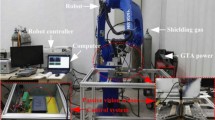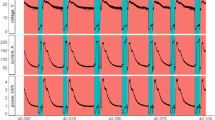Abstract
Wire and arc additive manufacturing (WAAM) process control is critical to forming dimensional accuracy. The online surface height measurement technology is one of the key technologies to achieve closed-loop control of the WAAM surface height. Measurement equipment such as charge-coupled device (CCD) or infrared cameras have difficulties in meeting the requirements for high-frequency online layer height measurement of multi-directional complex paths. In this paper, an online surface height measurement model (OSHMM) based on welding current, voltage, arc length signal, and motion system height displacement data is proposed that can measure the height value of the surface just below the tungsten electrode. The influence of large surface height deviation and the change of wire-feed rate, corner, and inclined edge on measurement accuracy were analysed. The experimental results show that the proposed method can guarantee the accuracy of ± 1.5 mm in the above cases.








Similar content being viewed by others
References
Ding D, Pan Z, Cuiuri D, Li H (2015) Wire-feed additive manufacturing of metal components: technologies, developments and future interests. Int J Adv Manuf Technol 81(1-4):465–481
Martin JH, Yahata BD, Hundley JM, Mayer JA, Schaedler TA, Pollock TM (2017) 3D printing of high-strength aluminium alloys. Nature 549(7672):365–369
Wang YM, Voisin T, McKeown JT, Ye J, Calta NP, Li Z, Zeng Z, Zhang Y, Chen W, Roehling TT, Ott RT, Santala MK, Depond Philip J, Matthews MJ, Hamza AV, Zhu T (2017) Additively manufactured hierarchical stainless steels with high strength and ductility. Nat Mater 17(1):63–71
Gu J, Ding J, Williams SW, Gu H, Bai J, Zhai Y, Ma P (2016) The strengthening effect of inter-layer cold working and post-deposition heat treatment on the additively manufactured Al–6.3Cu alloy. Mater Sci Eng A 651:18–26
Williams SW, Martina F, Addison AC, Ding J, Pardal G, Colegrove P (2016) Wire + arc additive manufacturing. Mater Sci Technol 32(7):641–647
Xie Y, Zhang H, Zhou F (2016) Improvement in geometrical accuracy and mechanical property for arc-based additive manufacturing using metamorphic rolling mechanism. J Manuf Sci Eng 138(11):111002
Ding D, Pan Z, Cuiuri D, Li H (2014) A tool-path generation strategy for wire and arc additive manufacturing. Int J Adv Manuf Technol 73(1-4):173–183
Ding D, Pan Z, Cuiuri D, Li H, van Duin S, Larkin N (2016) Bead modelling and implementation of adaptive MAT path in wire and arc additive manufacturing. Robot Comput Integr Manuf 39:32–42
Ding D, Pan Z, Cuiuri D, Li H, Larkin N (2016) Adaptive path planning for wire-feed additive manufacturing using medial axis transformation. J Clean Prod 133:942–952
Youheng F, Guilan W, Haiou Z, Liye L (2016) Optimization of surface appearance for wire and arc additive manufacturing of Bainite steel. Int J Adv Manuf Technol 91(1-4):301–313
Li Y, Han Q, Zhang G, Horváth I (2018) A layers-overlapping strategy for robotic wire and arc additive manufacturing of multi-layer multi-bead components with homogeneous layers. Int J Adv Manuf Technol 96(9-12):3331–3344
Li Y, Sun Y, Han Q, Zhang G, Horváth I (2018) Enhanced beads overlapping model for wire and arc additive manufacturing of multi-layer multi-bead metallic parts. J Mater Process Technol 252:838–848
Panchagnula JS, Simhambhatla S (2018) Manufacture of complex thin-walled metallic objects using weld-deposition based additive manufacturing. Robot Comput Integr Manuf 49:194–203
Lu X, Zhou YF, Xing XL, Shao LY, Yang QX, Gao SY (2017) Open-source wire and arc additive manufacturing system: formability, microstructures, and mechanical properties. Int J Adv Manuf Technol 93(5-8):2145–2154
Ding D, Shen C, Pan Z, Cuiuri D, Li H, Larkin N, van Duin S (2016) Towards an automated robotic arc-welding-based additive manufacturing system from CAD to finished part. Comput-Aided Des 73:66–75
Geng H, Li J, Xiong J, Lin X (2016) Optimisation of interpass temperature and heat input for wire and arc additive manufacturing 5A06 aluminium alloy. Sci Technol Weld Join 22(6):472–483
Zeng J, Chang B, Du D, Wang L, Chang S, Peng G, Wang W (2018) A weld position recognition method based on directional and structured light information fusion in multi-layer/multi-pass welding. Sensors 18(2):129–147
Yu Z, He Y, Xu Y, Chen H (2018) Vision-based deviation extraction for three-dimensional control in robotic welding with steel sheet. Int J Adv Manuf Technol 95(9-12):4449–4485
Xiong J, Zhang G (2013) Online measurement of bead geometry in GMAW-based additive manufacturing using passive vision. Meas Sci Technol 24(11):115103
Xiong J, Zhang G, Qiu Z, Li Y (2013) Vision-sensing and bead width control of a single-bead multi-layer part: material and energy savings in GMAW-based rapid manufacturing. J Clean Prod 41:82–88
Xiong J, Zhang G (2014) Adaptive control of deposited height in GMAW-based layer additive manufacturing. J Mater Process Technol 214(4):962–968
Li F, Chen S, Wu Z, Yan Z (2018) Adaptive process control of wire and arc additive manufacturing for fabricating complex-shaped components. Int J Adv Manuf Technol 96(1-4):871–879
Abe T, Sasahara H (2015) Development of the shell structures fabrication CAM system for direct metal lamination using arc discharge-lamination height error compensation by torch feed speed control. Int J Precis Eng Manuf 16(1):171–176
Cook GE (1983) Robotic arc welding: research in sensory feedback control. IEEE Trans Ind Electron 30(3):252–268
Guo H, Yu M, Liu J, Ning J (2004) Butterworth low-pass filter for processing inertial navigation system raw data. J Surv Eng 130(4):175–178
Eren L, Devaney MJ (2002) Calculation of power system harmonics via wavelet packet decomposition in real time metering. IEEE Instrumentation & Measurement Technology Conference
Ye G, Guo J, Sun Z, Li C, Zhong S (2018) Weld bead recognition using laser vision with model-based classification. Robot Comput Integr Manuf 52:9–16
Funding
This work is supported by the China Aerospace Science & Industry Corp Foundation (grant number HTKG2017ZJT21081).
Author information
Authors and Affiliations
Corresponding author
Additional information
Publisher’s note
Springer Nature remains neutral with regard to jurisdictional claims in published maps and institutional affiliations.
Recommended for publication by Commission I - Additive Manufacturing, Surfacing, and Thermal Cutting
Rights and permissions
About this article
Cite this article
Wang, X., Wang, A. & Li, Y. An online surface height measurement method for GTAW-based additive manufacturing. Weld World 64, 11–20 (2020). https://doi.org/10.1007/s40194-019-00813-1
Received:
Accepted:
Published:
Issue Date:
DOI: https://doi.org/10.1007/s40194-019-00813-1




